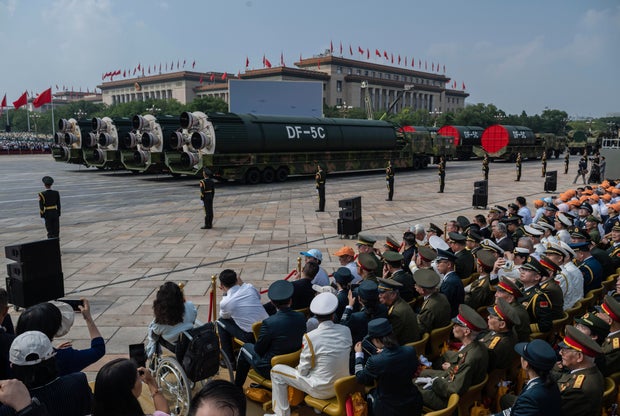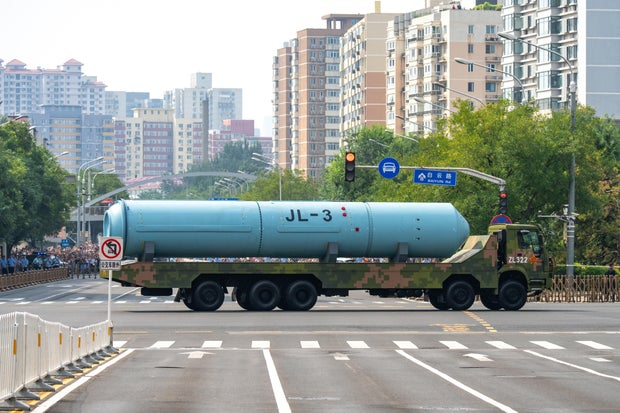China showed off a range of weapons and military hardware with a massive parade on Wednesday, staged in front of President Xi Jinping and 20 other heads of state, including Russian President Vladimir Putin and North Korean leader Kim Jong Un.
Here’s a look at some of the weapons that were on display, including some the world had not seen previously:
Drones, AI and lasers
China‘s LY-1 laser weapon was displayed during the parade for the first time, mounted on top of armored trucks. Defense analyst Alexander Neill told the BBC that the powerful device is believed to have the ability to disable electronics or blind pilots.
Zhao Wenyu/China News Service/VCG/Getty
There were a number of conventional drones on display, as well as some AI-powered ones.
One that drew particular attention was the AJX002 giant submarine drone, which measures approximately 65 feet long.
GREG BAKER/AFP/Getty
Also known as an extra-large uncrewed underwater vehicle, it could carry out reconnaissance or surveillance missions.
China also showed off stealth attack drones in the parade, including the GJ-11, which is capable of flying alongside manned fighter jets and aiding them in their missions.
Qilai Shen/Bloomberg/Getty
“Robotic wolves” were also on display. Experts say the four-legged, walking robots could be used for numerous operations, such as sweeping for mines, reconnaissance missions or hunting down enemy troops.
New nuclear-capable, long-range missiles
A new version of China’s Dongfeng-5 nuclear-capable intercontinental ballistic missile, the DF-5C, was unveiled for the parade. It is said to have a longer range than previous variants, Neill told the BBC. He said the missile can also carry up to 12 warheads on a single mission.
The new missile is silo-based, launched from underground facilities, and is meant to be a strategic deterrent, Neill said.
Kevin Frayer/Getty
According to The Associated Press, the DF-5C has an estimated range of about 12,400 miles, which makes it easily capable of reaching any part of the United States from mainland China.
A number of other nuclear-capable missiles were rolled down central Beijing’s Chang-an (“Eternal Peace”) Avenue, including the DF-61. Like the DF-5C, it is an intercontinental ballistic missile, but the DF-61 can be fired from a mobile launcher. Little is known about the new weapon, but the previous model has a range of more than 7,500 miles, and it can also carry multiple warheads.
VCG/VCG/Getty
The AP said China’s parade also featured the JL-1 and JL-3 nuclear-capable long-range missiles, the first of which is launched from aircraft and the second from vessels at sea.
China wants to “replace traditional structures”
“China not only wants to augment, but replace traditional structures,” defense analyst Michael Raska told CBS News partner network BBC News, adding that it seems to have taken lessons from Russia’s war in Ukraine, where a strategy has been to “throw drones at the enemy” to wear down their defenses.
GREG BAKER/AFP/Getty
While some countries are concerned about incorporating artificial intelligence into their military systems, China appears to be plowing ahead and “believe they can control AI,” Raska told the BBC. “They are going all the way to integrate it into their systems.”
The parade showed that China has the resources to build up a significant arsenal, but Raska said the U.S. still maintains the edge operationally.
The U.S. is more agile in battle because it has a “bottom-up” culture, where decisions can be made and adapted on the ground in response to evolving situations, Raska said. China, on the other hand, “can have flashy platforms and systems but they will not move a finger until they receive an order from the top,” Raska told the BBC.
GREG BAKER/AFP/Getty
“The Chinese think it’s technology that creates deterrence. They believe that will deter the U.S…. but at the operational level, there have been instances which show they may not be as good as they say they are,” Raska said.






